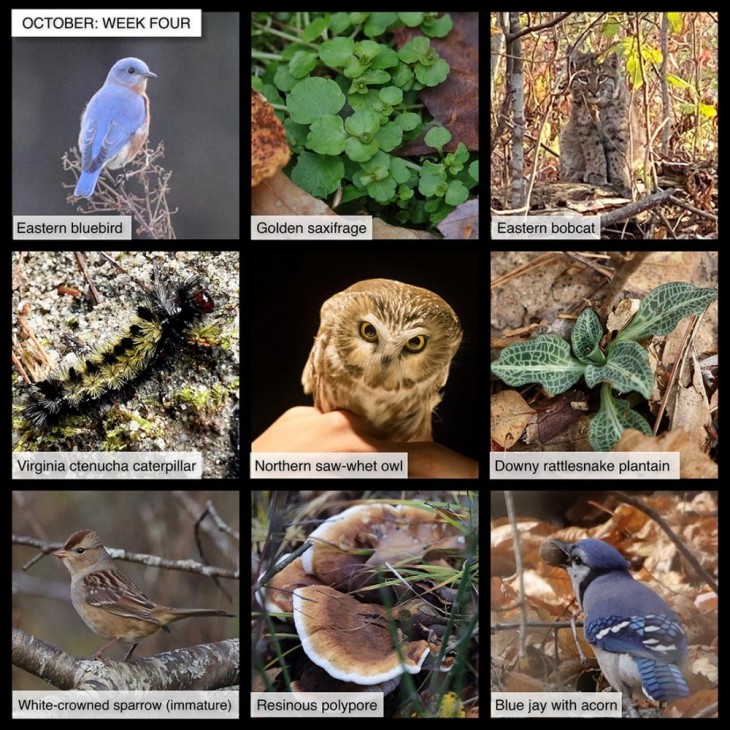This Week in the Woods, we’ve enjoyed watching flocks of eastern bluebirds on the edge of a meadow, feeding on insects in stands of young aspens. While they’re not as intensely colored as they were back in breeding season (we profiled them in April), they’re still exceptionally beautiful. Like their robin cousins, bluebirds take a flexible approach to migration, and their winter range has expanded in recent years. See this blog post from Maine Audubon, tracking a rapid rise in winter bluebird populations in that state since 2006 and suggesting some possible contributing factors, such as a rise in edge habitat and climate change. Fun fact: on cold nights, bluebirds will sometimes conserve heat by piling into a tree cavity together.
The name “saxifrage” comes from Latin: saxum means “rock” and fragere means “to break,” Many plants with this name are indeed colonizers of high, rocky places, but golden saxifrage grows in seeps and wetlands. This dainty plant, which stays bright green late into autumn, is common in our region. Here’s a profile from The Native Plant Trust.
Wow! Look who was peering out among the trees at Scott Nichols, on a sunny day last week in Lyme. As noted by ecologist John Litvaitis in this article about eastern bobcats from our Spring 2017 magazine, “bobcats are dramatic, mysterious, and almost never seen by people.” Litvaitis explains that, as recently as the late 1990s, northeastern bobcat populations were in serious decline. Their numbers are increasing now, perhaps in part due to the higher population of wild turkeys, which are common prey. Here’s a profile from Vermont Fish and Wildlife, noting that bobcat kittens require months to learn how to hunt and survive on their own: “This training is done by the female and may last into early winter.”
And speaking of hairy cats (quipped Meghan McCarthy McPhaul, who took this photo), Virginia ctenucha (teh-nu-cha) moth caterpillars are still crawling around. This is the larval form of a handsome black-blue-and-orange “wasp moth” that we frequently saw perched on milkweed blooms back in early summer. As noted in bugguide.net, the summer’s second brood of caterpillars overwinters “beneath leaf litter/matted grasses.” Here’s a link from The Caterpillar Lab with some nice close-up shots of the insect.
One of the major nature events of this season goes by mostly unseen: migratory birds moving through our region at night on their way to southern wintering grounds. Northern saw-whet owls, like bobcats, are a fairly common but elusive forest species. These beautiful little owls with big yellow eyes are on the move right now, and we’re grateful to North Branch Nature Center for letting us participate in an owl banding session last weekend. Here’s a link from NBNC describing its participation in Project OwlNet, a network of scientists that tracks owls’ migratory routes, overwintering sites, and other data critical for long-term conservation purposes.
Downy rattlesnake plantain, an evergreen orchid, becomes more noticeable as the forest floor turns brown. Supposedly, its name derives from the snakeskin-like pattern of its leaves, but the form of its inflorescence - flowers arrayed up a single spike - is reminiscent of a rattlesnake tail. Here’s a profile from the U.S. Forest Service.
It has been a birdy week. Migratory flocks of white-crowned sparrows have been appearing in meadows, where they feast on goldenrod seed heads – once again demonstrating the high wildlife value of this plant, and the wildlife benefits of leaving open areas unmowed. The birds breed in the Arctic and are passing through on their way to wintering grounds that stretch from the mid-Atlantic down into Mexico. Here’s a profile from Audubon, including sound files and images of adult birds. (The one we photographed is a “hatch year” youngster).
Resinous polypore, also known as “late fall polypore,” is a common autumn fungus that grows on dead wood. As Timothy Baroni notes in Mushrooms of the Northeastern States and Canada, it’s “very soft and fleshy for a polypore,” and “[in] wet weather, droplets of liquid may form on the cap margin and pore surfaces.” Here’s a link to the Maryland Biodiversity Project showing what those droplets look like.
Here’s one more bird to round out this week’s grid: the indomitable, often-outrageous blue jay. This time of year, the birds are feasting on acorns, and caching them for future consumption. In several instances this week, we’ve seen birds carrying acorns in their beaks. Here’s a fun video explaining the blue jay technique for acorn eating (always remember to wipe your beak!), and a recent Outside Story about the birds by Lee Emmons, notes that, “by caching nuts in the ground, blue jays helped spread these nut-bearing trees northward at the end of the Ice Age.”
Our thanks to The Frank and Brinna Sands Foundation for helping to support this series.
In this difficult period, many of us find joy in observing local nature, and many families are seeking outdoor enrichment opportunities for children. Here are nine photographs taken this past week, most within 15 miles of the Northern Woodlands office in Lyme, New Hampshire. We hope you enjoy using this grid as a prompt for your own explorations, or as the basis for a game of family forest tic-tac-toe.
What are you seeing in the woods this week? Share your images with us on Facebook, or submit a special photo for possible inclusion in our monthly online Reader Photo Gallery.


